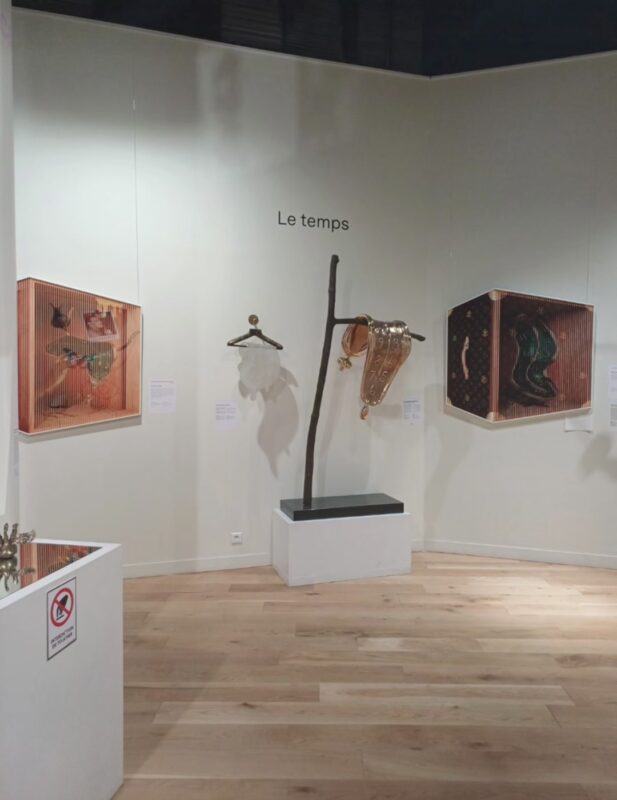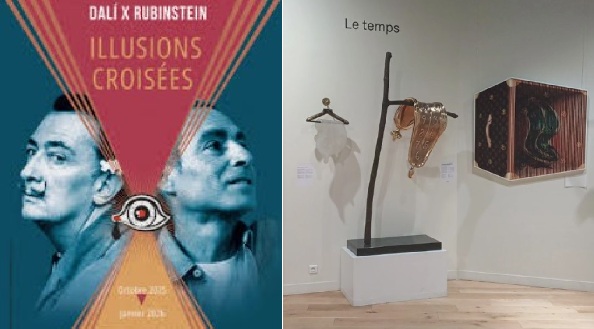“More than anything, I remember the future.” – Salvador Dalí
In an era where the very perception of reality is increasingly fluid and elusive, Dalí Paris announced the opening of an exhibition that creates a bridge between 20th-century Art and new artistic expressions.
The exhibition “Illusions Croisées” (Crossed Illusions), inaugurated on Friday, October 10, 2025, is an encounter between Salvador Dalí, the Master of Surrealism, and Patrick Rubinstein, the French pioneer of Kinetic Pop Art.
Running until January 30, 2026, in the heart of Montmartre, the permanent Dalí Paris museum, home to the largest private collection of Dalinian works, opens its doors to the optical and luminous language of a contemporary artist whose work extends and amplifies the surrealist visions of the Catalan genius.
This is far more than a simple homage; it is a true artistic duet that invites every visitor to question the immutability of images and the very nature of reality.
What connection can exist between Dalí’s dreamlike bronzes and visionary lithographs, and the optical vertigo generated by Rubinstein’s kinetic slats? The answer lies in a profound, shared fascination with illusion and the transformative power of perception.
Salvador Dalí was a tireless explorer of double images, anamorphoses, and visual enigmas, methods through which he sought to access the unconscious, transforming reality into a boundless mental landscape. His celebrated “Paranoiac-Critical Method” was the ultimate instrument: a tool to make the invisible visible, to layer meanings, and to unveil the latent obsession beneath the apparent form.
Patrick Rubinstein, born decades later, embraces this complex legacy and projects it into the future. Through his innovative techniques, the French artist creates striking works that literally metamorphose and break down into different figurations depending on the spectator’s angle of observation. His kinetic and luminous art compels the visitor to move, to dance around the artwork, to complete its meaning.
In this dynamic exchange, the observer becomes an active participant. For both artists, the experience of the work is inherently participatory; the observer becomes the co-creator of the illusion.
As the Master himself loved to declare: “I am Surrealism”; with the Illusions Croisées exhibition, the Dalí Universe suggests that this essential spirit is not confined to the past, but exists and evolves in the present, finding new life in Rubinstein’s visionary interactivity.
The exhibition is conceived as an immersive, thematic journey where Dalinian icons confront Rubinstein’s vibrant Pop reinterpretations. Both artists share a universe of obsessions which, although expressed with distinct contemporary and classic languages, converge around the fundamental concepts of time and its fluidity, femininity, metamorphosis, and symbolism.
.

.
No theme is more Dalinian or universally recognisable than melted time. Dalí’s bronze sculptures depicting the soft watches, symbols of the relativity of time, are juxtaposed with the kinetic works Rubinstein created.
In these creations, time is not merely fused; it breaks down, reflects, and multiplies in optical sequences that underscore its elusive and non-linear aspect. Dalí declared: “Time is one of the few important things that remain to us”. Rubinstein, with his sheer dynamism, renders it a truly intangible and mutable entity.
The figure of the woman, muse, enigma, and obsession, is central to the iconography of both artists, from the “Space Venus” conceived by Dalí, concealing Freudian secrets and anatomical drawers, to Rubinstein’s colourful female figures inspired by Pop Culture.
Angels, mythical figures, and the butterfly are shared messengers of transformation. For Dalí, the butterfly represents the metamorphosis, the lightness of the dream, and the freedom of the unconscious, while for Rubinstein, omnipresent in his canvases, it symbolizes the impermanence of the image itself and the continuous possibility of visual rebirth.
Through a scenography that dramatically enhances the play of light and perspectives, the “Illusions Croisées” exhibition is more than a mere display; it is a hypnagogic experience that seamlessly merges the surreal dimension with the kinetic.
Dalí’s bronze sculptures, rich in symbolism and classical mastery, engage in a powerful dialogue with the modern polychromy and movement effect of Rubinstein’s art, creating a startling tête-à-tête that completely disorients our points of reference.
Dalí is not merely an artist of the past, but a visionary whose message continues to resonate powerfully in the future, as he himself declared: “More than anything, I remember the future.”
The “Illusions Croisées” exhibition at Dalí Paris will be open to the public until Friday, January 30, 2026.

